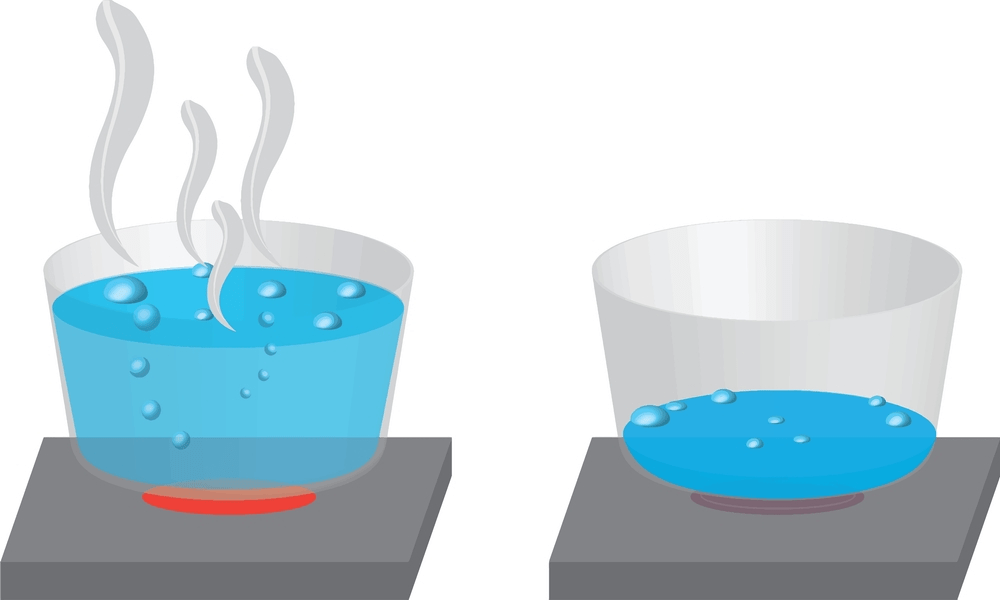Aim: To evaluate factors affecting the rate of evaporation.
Requirements:
Chemicals: Water, sodium chloride, glycerin.
Instruments/ apparatus: Water bath, thermometer, weighing balance, beakers (50, 100, 250, and 500 ml), stirrer, measuring cylinder.
Principle of factors affecting rate of evaporation
- Evaporation is the process of vaporizing large quantities of volatile liquid to get a concentrated product. The rate of evaporation depends on several factors temperature, viscosity, the concentration of slurry, vapor pressure, surface area, and time of evaporation, films, and deposits.
- The higher the temperature greater will be the rate of evaporation. The greater the surface area of liquid, the greater will be the rate of evaporation.
- Films and deposits formed during evaporation reduce the rate of evaporation. The higher the viscosity of the slurry lowers the rate of evaporation and the same is for the higher concentration of the solid.

Procedure:
Effect of Surface Area on Rate of Evaporation
- Four beakers of different sizes (50,100, 250, and 500ml) are taken.
- All beakers are thoroughly cleaned and weighed individually (The weight of the individual beaker is denoted W1).
- Four different heating mantles are arranged and the temperature is set to 80°C.
- 30ml of water is placed in all the beakers.
- All the beakers with water were weighed individually and the values are recorded as W2. (beaker +water)
- The beakers are placed on heating mantles and heated for 30 minutes.
- Ager 10min all the beakers are cooled carefully.
- Ager cooling again all the beakers are weighed individually and the weights are recorded as W3.
- The difference in initial and final weight is determined and the weight of water evaporated is noted.
- The radius, Surface area of beakers, and the rate of evaporation are calculated by using respective formulae.
- A graph is plotted by taking the surface area of the beakers on the X-axis and the rate of evaporation on Y – the axis.
- The effect of surface area on the rate of evaporation is noted.
Effect of concentration on rate of evaporation:
- Six beakers of the same size are taken.
- All beakers are thoroughly cleaned and weighed individually (The weight of the individual beaker is denoted W1).
- Six different heating mantles are arranged and the temperature is set to 80°C.
- Different concentrations of NaCl (2%,4%,6%,8%,10%and 20%)is prepared
- 50ml of the prepared solution is transferred to the beakers.
- All the beakers with the solution were weighed individually and the values are recorded as W2. (beaker + Solution)
- The beakers are placed on heating mantles and heated for 30 minutes.
- Ager 30min all the beakers are cooled carefully.
- Ager cooling again all the beakers are weighed individually and the weights are recorded as W3.
- The difference in initial and final weight is determined and the weight of water evaporated is noted.
- The rate of evaporation is calculated by using the respective formula.
- A graph is plotted by taking the concentration of the solution(%)on the X-axis and the rate of evaporation on Y- the axis.
- The effect of concentration on the rate of evaporation is compared.
Effect of Viscosity on Rate of Evaporation:
- Five beakers of the same size are taken.
- All beakers are thoroughly cleaned and weighed individually (The weight of the individual beaker is denoted W1).
- Five different heating mantles are arranged and the temperature is set to 80°C.
- Different concentrations of glycerin in 100 ml water(2.5%, 5%, 7.5%, 10 %, and 12.5 %) are prepared in different beakers.
| Glycerin (ml) | Water (ml) | Concentration % v/v |
| 2.5 | 97.5 | 2.5 |
| 5 | 95 | 5 |
| 7.5 | 92.5 | 7.5 |
| 10 | 90 | 10 |
| 12.5 | 88.5 | 12.5 |
- 50ml of the prepared solution is transferred to the beakers.
- All the beakers with the solution were weighed individually and the values are recorded as W2. (beaker + Solution)
- The beakers are placed on heating mantles and heated for 30 minutes.
- Ager 30min all the beakers are cooled carefully.
- Ager cooling again all the beakers are weighed individually and the weights are recorded as W3.
- The difference in initial and final weight is determined and the weight of water evaporated is noted.
- The rate of evaporation is calculated by using the respective formula.
- The effect of viscosity on the rate of evaporation is compared.
I) Effect of surface area on the rate of evaporation
Time of heating:
Rate of evaporation = Quantity of water evaporated/ Time of heating in minutes
Observation Table:
| Parameters | 50ml | 100ml | 250ml | 500ml |
| Radius of Beaker | ||||
| The surface area of the beaker (cm2) | ||||
| Weight of empty beaker W1(g) | ||||
| Weight of beaker with water W2(g) | ||||
| Weight of water before evaporation (W2– W1) a (g) | ||||
| Weight of beaker + water ager evaporation (W3) g | ||||
| Weight of water ager evaporation (W3-W1) b (g) | ||||
| Weight of water evaporated (a-b) g | ||||
| Rate of evaporation (a-b/30) g/min |
II) Effect of concentration on rate of evaporation:
Rate of evaporation = Quantity of water evaporated/ Time of heating in minutes
Observation Table
| Parameters | 2% | 4% | 6% | 8% | 10% | 20% |
| The concentration of the solution (%) | ||||||
| Weight of empty beaker W1(g) | ||||||
| Weight of beaker with solution W2(g) | ||||||
| Weight of solution before evaporation (W2– W1) a (g) | ||||||
| Weight of beaker + Solution ager evaporation (W3) g | ||||||
| Weight of Solution ager evaporation (W3-W1) b(g) | ||||||
| Weight of water evaporated (a-b) g | ||||||
| Rate of evaporation (a-b/30) g/min |
III) Effect of viscosity on the rate of evaporation:
Observation Table:
| Parameters | 2.5% | 5% | 7.5% | 10% | 12.5% |
| Weight of empty beaker W1(g | |||||
| Weight of beaker with solution W2(g) | |||||
| Weight of water before evaporation (W2– W1) a (g) | |||||
| Weight of beaker + water ager evaporation (W3) g | |||||
| Weight of water ager evaporation (W3-W1) b(g) | |||||
| Weight of water ager evaporation (W3-W1) b(g) | |||||
| Weight of water ager evaporation (W3-W1) b(g) |
Result:
The effect of surface area, concentration and viscosity rate of evaporation is studied and the findings are,
- The rate of evaporation …………………with surface area.
- The rate of evaporation …………………with concentration.
- The rate of evaporation …………………with the viscosity.
Make sure you also check our other amazing Article on: How concentration of slurry affect the rate of filtration?
